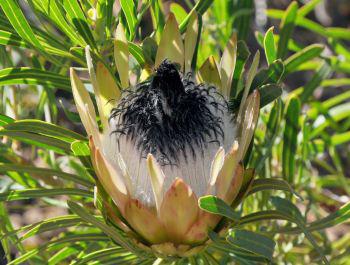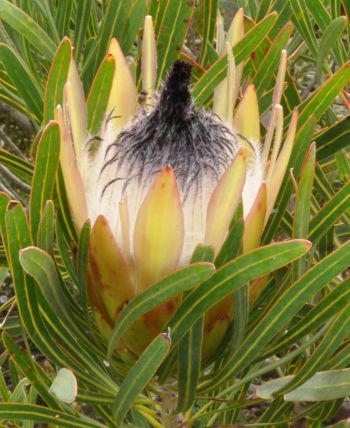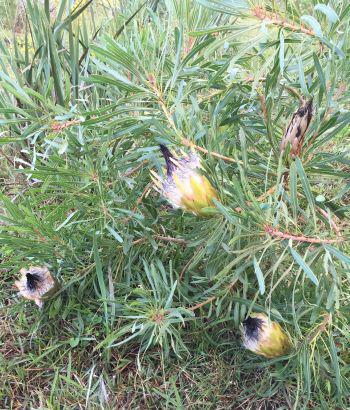Protea longifolia
Protea longifolia Andrews
Family: Proteaceae
Common names: long-leaf sugarbush, long-leaf protea (Eng.); langblaarsuikerbos (Afr.)
Introduction
A fast-growing protea, which is easily recognized by its extended central mass of flowers with black-bearded tips, and various flower colours of yellow-green, creamy white and light orange-pink, and makes an excellent, small, spreading fynbos shrub for the garden.

Description
Description
An evergreen, fynbos shrub that grows about 0.5–1.5 m high and up to 2 m wide. The stems are hairless when mature and the branches are spreading, sometimes touching the ground, if not pruned. Protea longifolia produces sclerophylous, curved, grey-green leaves, often with a twist, pointing upwards and has one, visible, primary leaf vein in each leaf. The leaves are tapering at the base, linear to linear-spatulate, 90–200 mm long and 5–17 mm wide.

The flower is a flowerhead or inflorescence made up of many small flowers massed together inside a cup of floral bracts. Male and female elements are carried in the same flower; female consist of a stigma and pollen presenter, style and ovary; male consists of stamens and anthers. The style is about 40–65 mm long and pollen presenter of 7–10 mm long. The flowerheads are oblong-obconic, 80–160 mm long and 40–90 mm in diameter. They vary from green to white to pink; the involucral bracts are hairless, with inner series 12–15 mm long and outer series 70–120 mm long. The outer series bracts are always shorter than the inner series and are lighter in colour than the outer series. Long-leaf sugarbush has a noticeable black-beard on the central peak of flowers, that is longer than the involucral bracts. Protea longifolia flowers from autumn until spring, (May to September) and produces its flowers abundantly during mid-winter, in June and July.

The fruits are serotinous and are retained within the flowerhead on the plant for years. The fruits take about 7 months of ripening.
There is a distinct dwarf form from Elim Flats called Protea longifolia var. minor (mini long-leaf sugarbush). This variety has green involucral bracts and a short flowerhead of 80–120 mm long and grows up to 0.5 m high. It is similar to Protea pudens (Rebelo 2001).
Conservation Status
Status
According to the Red List of South African Plants, checked on 10 November 2016, Protea longifolia is assessed as Vulnerable (VU), meaning that it is threatened. The wild populations of Protea longifolia are decreasing because of the threats of harvesting, habitat loss due to commercial protea cultivation for the past ten to twenty years, changes in native species, habitat degradation and the presence of invasive alien species.
Distribution and habitat
Distribution description
Protea longifolia grows naturally in gravel flats and in sandy soil on the lower slopes from Du Toit’s Kloof to Riversonderend and Bredasdorp Mountain and on the Elim Flats. It seldom forms dense stands and is sparsely distributed.

Derivation of name and historical aspects
History
The genus Protea was named by Carl Linnaeus, the father of taxonomy, because Proteus was the mythological Greek god who could see into the future and always spoke the truth. However, to be able to extract a prophecy, one has to grasp him while he changed into numerous animate or inanimate forms. Longifolia is Latin and means ‘long-leaf’.
The Proteaceae is a family of one magnificent flowering plant after another. It comprises of more than 1 700 species and 80 genera. Most of the about 800 species and 45 genera are native to Australia. Africa has about 400 species of which 352 species occur in South Africa, mainly in the winter-rainfall area of the southwestern Cape. Other species occur in Central and South America, island east of New Guinea, New Caledonia, Madagascar, Southeast Asia, New Guinea and New Zealand.
Ecology
Ecology
Most proteas are pollinated by nectar-feeding birds and mostly the visitors are sunbirds and sugarbirds. Protea Beetles (Trichostetha fascicularis) and other Scrarabaeidae are also important pollinators of protea flowers. Sugarbirds are dependent on proteas, pagodas and pincushions for food in winter season.
When a protea dies or is killed by fire, the seed heads open and the serotinous (retained) fruits fall or are blown away from the plant. The seeds become available as food for rodents and birds until they germinate after the winter rain. The seeds of Protea longifolia has a soft coat of hairs that hold the seed into the soil after dispersal by wind after fire.
The leaves are sclerophyllous, which prevents the loss of water during the dry and hot season.
Protea longifolia has a single stem at ground level, and if killed by fire it will not resprout. Its adaptation to fire is reseeding, i.e. to produce masses of seeds after the fire.
The proteoid roots of proteas, which form a dense mat not far from the soil surface, have a surface area fifteen times that of non-proteoid roots, absorbing the tiny amounts of nutrients available from the very nutrient-poor soils of the Cape mountains.
Protea longifolia is one of the most promiscuous proteas and frequently forms natural hybrids with neighbouring Protea species. It hybridizes easily with Protea compacta, P. magnifica, P. repens and P. nerifolia and these hybrids occur both in cultivation and in nature (Matthews 1993).

Uses
Use
Protea longifolia is a magnificent garden shrub, suitable for use in landscaping, specifically in areas where a lower growing and spreading shrub is needed in a fynbos garden. It requires a bit of pruning after flowering, to encourage the new growth and to shape the plant into a compact bush.
Protea longifolia hybrids are used in the cut flower industry, however, the true species is not a magnificent cut flower. Many hybrids are popular cut flowers and are used by floral artists, and and are also rewarding garden shrubs, e.g. Protea repens x longifolia ‘Liebencherry’ and Protea magnifica x longifolia ‘Pinita’.
Growing Protea longifolia
Grow
Protea longifolia is easy to grow and responds well when propagated by seed, however, cuttings is also used but takes a while to root. Sow the seed in autumn, March to May, in a well-drained sowing medium of coarse sand and fine-milled pine bark. The dropping of the temperature in autumn breaks dormancy and stimulates the germination of fynbos seed. The optimum temperature for germination is 5–10ºC for night temperature and 15–20ºC for day temperature. It is important to select the fertile seeds before sowing; fertile seeds are plump, whereas unfertile seeds are not. Protea seeds are very sensitive to waterlogging. Use a well-aerated pot with good drainage. Smoke treating the seed with dry and green fynbos material stimulates germination. At Kirstenbosch, seed trays are placed in a plastic tent into which smoke from burned fynbos is piped. Smoke extract is also available for sale from the seedroom. Treat your seed with a dusting systemic fungicide which contains the active ingredient metalaxyl, to prevent the post emergence seedling infection.
After sowing cover the seed with a light layer of sand to cover any exposed seeds. Keep the soil moist and apply fungicide once a week. To prevent birds and rodents from eating the seeds, cover the benches or trays with a grid. Once the seeds have germinated, they will produce the cotyledons, followed by true leaves. The seedlings are ready to be transplanted into small plastic bags or into compartmentalized trays when they have true leaves. Place the potted up seedlings under shade net for hardening off if conditions are dry and hot. At Kirstenbosch the seedlings are placed in a shade net in the nursery until they are ready to be planted into the garden after a period of 1 to 2 years. Shade net reduces the direct sun which can dry out the soil in the plastic bags and can also prevent the scorch.
Protea longifolia is a water-wise shrub once it is established in the garden, normally 3 years after it has been planted in the garden. Plant the seedlings in acidic soil preferable between 5–7 pH levels. Protea longifolia grows naturally in nutrient-poor soils, more specifically where phosphorus is scarce. Use lower concentratons of organic fertilizer to encourage the sensitive proteoid root and avoid using artificial fertilizers containing phosphorus, as they can cause the plants to collapse and eventually die.
Protea longifolia can also be propagated by cuttings. The cuttings can be taken in summer, from November to April, from the semi-hard growth of the current season. Select disease-free cuttings of 200 to 250 mm long from upright-growing lateral shoots. Dip the cutting in rooting hormone for at least 5 seconds. Place your cuttings in a well-drained and aerated rooting medium of 70% perlite and 30% fine-milled bark, or coarse sand and finely milled pine bark, in multi-trays. Put the trays on bottom heated benches of 22–25ºC and regularly treat the cuttings with the fungicide to prevent fungal infections. Remove the dead leaves and wilting cuttings until your cuttings are rooted. Rooting the cutting of Protea longifolia is quite difficult and the cutting can take 3 months to root. Monitor the cuttings and if not rooted, damage the callus, retreat with rooting hormone and replant in fresh rooting medium.
Keep the soil moist during the hot dry summer season by mulching your bed with an about 5 mm thick layer of compost. The mulch will keep the roots cool, keep moisture in the soil and reduce the growth of weeds. Protea longifolia needs to be pruned after flowering to encourage the new growth and to compact bush.
Nocturnal beetle such as Snout Beetle can cause leaf damage by feeding on the leaves during the night. Control the beetle by using a bright torch in the night and place a wide, open container under the tree and shake them off and crush their hard exteriors. Protea longifolia is also susceptible to Phytophthora cinnamomi. Graft Protea longifolia scion on hybrid ‘Pink Ice’, a cross between Protea compacta and P. susannnae. There are various hybrids that are resistant to phytophthora and other various pathogens which can be used. At Kirstenbosch in the motherstock area, P. longifolia plants are doing very well without hand watering. Phytophthora spores become more active when the soil is warm and wet in summer season. Planting in winter season in Mediterranean area encourage the roots of plant to spread and goes deep into the soil to avoid the need for watering in summer time.
Protea longifolia has been reported to be affected by Armillaria. To control the pathogen, apply the prevention method of avoiding to use the infected mulch, bark chipping, compost, chipping wood and bark and remove the infected plant and burn it immediately.
References
- Biodiversity Explorer. Protea longifolia page: http://www.biodiversityexplorer.org/plants/proteaceae/protea_longifolia.htm, accessed 14 November 2016.
- Broembsen, V.S. 1984. Occurrence of Phytophthora cinnamomi on indigenous and exotic host in South Africa, with special reference to the south-western Cape Province. Plant Protection Research Institute. Stellenbosch.
- Brown, N.A.C. & Duncan, G.D. 2006. Grow fynbos plants. Kirstenbosch Gardening Series. South African National Biodiversity Institute, Cape Town.
- Crous, W.P., Denman, S., Taylor, E.J., Swart, L., Bezuidenhout, M.C., Hoffman, L., Palm, E.M. & Groenewald, J.Z. 2013. Cultivation and diseases of Proteaceae: Leucadendron, Leucospermum and Protea. BIO CBS Biodiversity Series. The Netherlands.
- Duncan, G., Brown, N. & Nurrish, L. 2013. Grow proteas. Kirstenbosch Gardening Series. South African National Biodiversity Institute, Cape Town.
- Manning, J. & Goldblatt, P. 2012. Plants of the Greater Cape Floristic Region 1: the Core Cape Flora. Strelitzia 29. South African National Biodiversity Institute, Pretoria.
- Matthews, L.J. paintings by Zoe Carter. 1993. Proteas of the world. Auckland, New Zealand.
- Protea Atlas Project. Meanings of scientific names. http://www.proteaatlas.org.za/meanings.htm, accessed 14 November 2016.
- Rebelo, A.G. 2001. Proteas. A field guide to the proteas of southern Africa, edn 2. Fernwood Press, Vlaeberg, Cape Town.
- Rebelo, A.G. et al. 2006. Protea longifolia Andrews. National Assessment: Red List of South African plants version 2015.1. Accessed on 2016/11/14.
- Rebelo, A.G. 2000. Proteas of the Cape Peninsula. Protea Atlas Project. National Botanical Institute, Cape Town.
Credits
Mashudu Nndanduleni
Kirstenbosch National Botanical Garden
December 2016
Plant Attributes:
Plant Type: Shrub
SA Distribution: Western Cape
Soil type: Sandy, Loam
Flowering season: Spring, Autumn, Winter
PH: Acid
Flower colour: Black, Green, White, Pink, Cream
Aspect: Full Sun
Gardening skill: Easy
Special Features:
Horticultural zones







Rate this article
Article well written and informative
Rate this plant
Is this an interesting plant?
User Comments
Zakhele Zakes Tshabangu , South Africa
March 23, 2017 at 11:32 AMCan one grow these magnificent plants in the Eastern Gauteng region?
Alice Notten
March 27, 2017 at 1:56 PMMany proteas are tricky to grow, even in their home range.
These are the basics to follow:
they need sandy acidic soil that is well-drained, e.g. on a slope;
they don't like rich, manured or heavy soils or soil that is high in phosphates;
they don't like wet soggy soils, although they like water, but it must drain through, not stand;
they don't like still humid air, they prefer an open airy spot with free air circulation;
they don't like to get hot and humid but can deal with dry heat;
they also don't like to have us scratch around their base, as we tend to do in gardens, as they are very susceptible to fungi that attack via a break in the root;
Frost is not necessarily their worst enemy, they should survive short dips to zero but not prolonged exposure to freezing temperatures.
So if you can provide a home that meets these needs, then yes, you can grow them.
Login to add your Comment
Back to topNot registered yet? Click here to register.